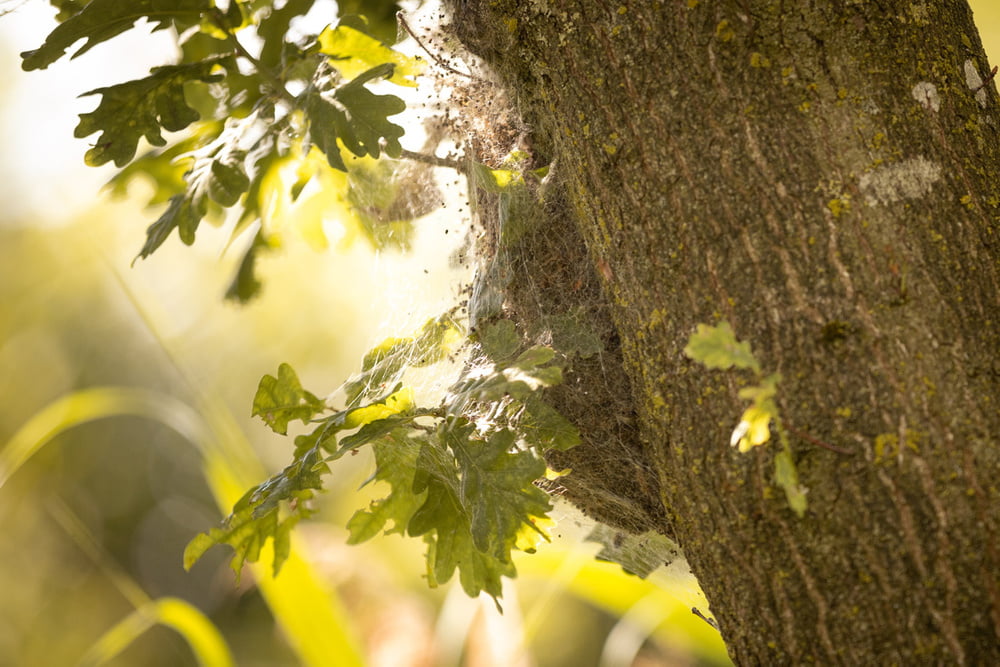The caterpillar of the oak processionary moth has it all: its hairs contain an aggressive nettle toxin that can cause severe skin and respiratory irritations. We explain how you can recognize and combat the oak processionary moth.
The oak processionary moth loves warm, dry climates. As summers become hotter and drier in Europe, the oak processionary moth is increasingly spreading northward.
The moth gets its name from the fact that it prefers to settle in oak forests, sometimes also oak forests interspersed with hornbeam or pine. In exceptional cases, however, the oak processionary moth also attacks other deciduous tree species.
Oak processionary moths particularly like to nest in oaks or other deciduous trees in sunny free-standing places, often also in parks, swimming pools or schoolyards. You may even encounter the oak processionary moth in your yard.
Contents
Recognize oak processionary moth
To control it, you must first recognize the oak processionary moth.
In July and August, you may see the adult moths flying. The adults have a wingspan of about 3 centimeters and are inconspicuously colored a brownish gray.
Adults do not pose a direct threat to humans.
You can recognize the caterpillars of the oak processionary moth by their broad, dark-colored dorsal line and the long hairs that grow from reddish-brown warts. These hairs contain a toxin that irritates the skin and respiratory tract.
Danger from the oak processionary moth
These long fine hairs of the oak processionary moth caterpillars contain the toxin thaumetopoein, which can cause sensitive allergic reactions on the skin of humans, known as caterpillar dermatitis.
In addition, the hairs have barbs that bore into the skin. If the hairs are inhaled, they can also cause dangerous respiratory irritation.
The problem is exacerbated by the fact that the hairs break off easily. Carried away by the wind, they can easily be inhaled and cause great damage without even being near a nest. In the process, the hairs can be carried several hundred feet.
In addition, the oak processionary moth’s venom remains active for up to three years, so entire children’s playgrounds and parks can be affected for years. Even when picnicking, mowing the lawn or doing other work in your own yard, you are still at risk for years to come.
The hairs remain dangerous even in winter: the toxin they contain survives even cold temperatures, and the hairs can be carried away by the wind and inhaled by people.
Controlling the oak processionary moth
The caterpillars of the oak processionary moth form the dangerous stinging hairs after the second molt, around April and May. To prevent an infestation, appropriate measures must therefore be taken at the end of March or beginning of April.
In doing so, it is imperative to enlist the help of professionals who know how to deal with oak processionary moth nests as well as how to handle the chosen insecticide. In this way, the dangers to people and the environment are kept to a minimum.
As a private individual, you should refrain from controlling the oak processionary moth yourself. When vacuuming, wet spraying or lighting the nests, the stinging hairs are stirred up and thus become a real danger.
Control oak processionary moth naturally
However, you can design your garden so that the natural enemies of the oak processionary moth find enough food and nesting places in it.
These include, for example, various birds such as the cuckoo and hoopoe, various species of wasps such as braconid wasps and ichneumon wasps, and bats.
For example, you can hang nesting boxes. The bird parents will be grateful for the abundant food supply in the immediate vicinity.
However, these measures promise only limited success in controlling the oak processionary moth. Therefore, if you discover a nest, it is best to contact a pest control professional. Also, remember to inform your community if the nest is in a public area and avoid the area until the oak processionary moth is dispersed.


